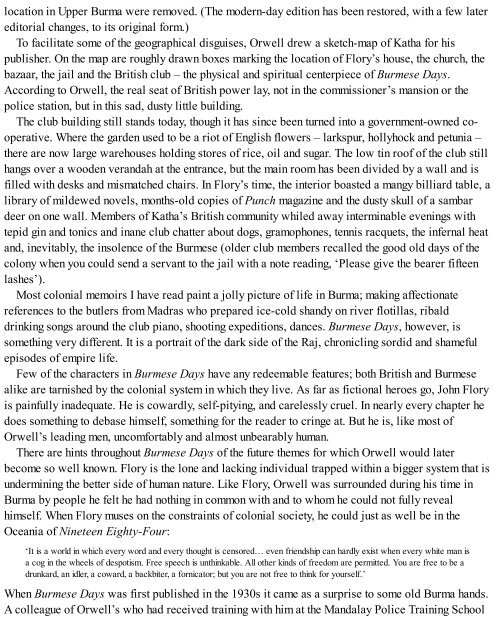563296589345
Create successful ePaper yourself
Turn your PDF publications into a flip-book with our unique Google optimized e-Paper software.
location in Upper Burma were removed. (The modern-day edition has been restored, with a few later<br />
editorial changes, to its original form.)<br />
To facilitate some of the geographical disguises, Orwell drew a sketch-map of Katha for his<br />
publisher. On the map are roughly drawn boxes marking the location of Flory’s house, the church, the<br />
bazaar, the jail and the British club – the physical and spiritual centerpiece of Burmese Days.<br />
According to Orwell, the real seat of British power lay, not in the commissioner’s mansion or the<br />
police station, but in this sad, dusty little building.<br />
The club building still stands today, though it has since been turned into a government-owned cooperative.<br />
Where the garden used to be a riot of English flowers – larkspur, hollyhock and petunia –<br />
there are now large warehouses holding stores of rice, oil and sugar. The low tin roof of the club still<br />
hangs over a wooden verandah at the entrance, but the main room has been divided by a wall and is<br />
filled with desks and mismatched chairs. In Flory’s time, the interior boasted a mangy billiard table, a<br />
library of mildewed novels, months-old copies of Punch magazine and the dusty skull of a sambar<br />
deer on one wall. Members of Katha’s British community whiled away interminable evenings with<br />
tepid gin and tonics and inane club chatter about dogs, gramophones, tennis racquets, the infernal heat<br />
and, inevitably, the insolence of the Burmese (older club members recalled the good old days of the<br />
colony when you could send a servant to the jail with a note reading, ‘Please give the bearer fifteen<br />
lashes’).<br />
Most colonial memoirs I have read paint a jolly picture of life in Burma; making affectionate<br />
references to the butlers from Madras who prepared ice-cold shandy on river flotillas, ribald<br />
drinking songs around the club piano, shooting expeditions, dances. Burmese Days, however, is<br />
something very different. It is a portrait of the dark side of the Raj, chronicling sordid and shameful<br />
episodes of empire life.<br />
Few of the characters in Burmese Days have any redeemable features; both British and Burmese<br />
alike are tarnished by the colonial system in which they live. As far as fictional heroes go, John Flory<br />
is painfully inadequate. He is cowardly, self-pitying, and carelessly cruel. In nearly every chapter he<br />
does something to debase himself, something for the reader to cringe at. But he is, like most of<br />
Orwell’s leading men, uncomfortably and almost unbearably human.<br />
There are hints throughout Burmese Days of the future themes for which Orwell would later<br />
become so well known. Flory is the lone and lacking individual trapped within a bigger system that is<br />
undermining the better side of human nature. Like Flory, Orwell was surrounded during his time in<br />
Burma by people he felt he had nothing in common with and to whom he could not fully reveal<br />
himself. When Flory muses on the constraints of colonial society, he could just as well be in the<br />
Oceania of Nineteen Eighty-Four:<br />
‘It is a world in which every word and every thought is censored… even friendship can hardly exist when every white man is<br />
a cog in the wheels of despotism. Free speech is unthinkable. All other kinds of freedom are permitted. You are free to be a<br />
drunkard, an idler, a coward, a backbiter, a fornicator; but you are not free to think for yourself.’<br />
When Burmese Days was first published in the 1930s it came as a surprise to some old Burma hands.<br />
A colleague of Orwell’s who had received training with him at the Mandalay Police Training School









![Genki - An Integrated Course in Elementary Japanese II [Second Edition] (2011), WITH PDF BOOKMARKS!](https://img.yumpu.com/58322134/1/180x260/genki-an-integrated-course-in-elementary-japanese-ii-second-edition-2011-with-pdf-bookmarks.jpg?quality=85)
![Genki - An Integrated Course in Elementary Japanese I [Second Edition] (2011), WITH PDF BOOKMARKS!](https://img.yumpu.com/58322120/1/182x260/genki-an-integrated-course-in-elementary-japanese-i-second-edition-2011-with-pdf-bookmarks.jpg?quality=85)





